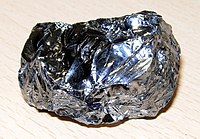
Photo from wikipedia
The nanostructure design of a prereserved hollow space to accommodate 300% volume change of silicon anodes has created exciting promises for high-energy batteries. However, challenges with weak mechanical stability during… Click to show full abstract
The nanostructure design of a prereserved hollow space to accommodate 300% volume change of silicon anodes has created exciting promises for high-energy batteries. However, challenges with weak mechanical stability during the calendering process of electrode fabrication and poor volumetric energy density remain to be solved. Here we fabricated a pressure-resistant silicon structure by designing a dense silicon shell coating on secondary micrometer particles, each consisting of many silicon nanoparticles. The silicon skin layer significantly improves mechanical stability, while the inner porous structure efficiently accommodates the volume expansion. Such a structure can resist a high pressure of over 100 MPa and is well-maintained after the calendering process, demonstrating a high volumetric capacity of 2041 mAh cm-3. In addition, the dense silicon shell decreases the surface area and thus increases the initial Coulombic efficiency. With further encapsulation with a graphene cage, which allows the silicon core to expand within the cage while retaining electrical contact, the silicon hollow structure exhibits a high initial Coulombic efficiency and fast rise of later Coulombic efficiencies to >99.5% and superior stability in a full-cell battery.
Journal Title: Nano letters
Year Published: 2018
Link to full text (if available)
Share on Social Media: Sign Up to like & get
recommendations!